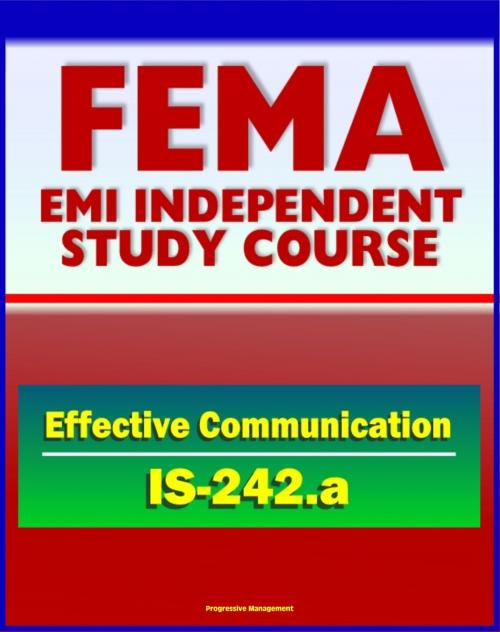21st Century FEMA Study Course: Effective Communication (IS-242.a) - Hearing versus Listening, Media Interviews, Templates for Written Communications, Humor, Nonverbal Cues and Clusters
Nonfiction, Social & Cultural Studies, Political Science| Author: | Progressive Management | ISBN: | 9781465932013 |
| Publisher: | Progressive Management | Publication: | July 7, 2011 |
| Imprint: | Smashwords Edition | Language: | English |
| Author: | Progressive Management |
| ISBN: | 9781465932013 |
| Publisher: | Progressive Management |
| Publication: | July 7, 2011 |
| Imprint: | Smashwords Edition |
| Language: | English |
This Federal Emergency Management Agency (FEMA) independent training course manual from the Emergency Management Institute (EMI) is designed to improve your communication skills. It addresses:
Basic communication skills
How to communicate in an emergency
How to identify community-specific communication issues
Using technology as a communication tool
Effective oral communication
How to prepare an oral presentation
Topics covered include: Hearing versus listening; media interviews; nonverbal messages; community-specific communications issues; communications technology; oral presentations; speech anxiety; nonverbal cues; nonverbal clusters; humor; templates for written communications; active listening.
Unit 1 offers an overview of the course content.
Unit 2 discusses basic communication skills and styles.
Unit 3 examines communication during emergency situations.
Unit 4 addresses community-specific communication needs and the particular needs, risks, sensitivities, expectations, and norms that are relevant to disaster communication.
Unit 5 presents both low- and high-technology communication tools and discusses how to choose among them.
Unit 6 focuses on effective oral communication, the role of nonverbal cues, and ways to match your message to your audience.
Unit 7 discusses how to develop a successful oral presentation.
Unit 8 summarizes the course content.
During an emergency, it is especially challenging and important to communicate accurate information clearly to the target audience. Disaster survivors generally look for someone who can communicate valuable guidance, provide leadership, and lead them in problem solving. When you successfully fill that role, you act to reassure survivors that their government and private organizations are working toward community recovery.
Finely tuned communication skills are also important tools during the emergency planning phase when educating the public about preparedness. It is easy to take communicating for granted because it is a daily activity. How much thought have you given to communication? Are you aware that:
The average worker spends 50 percent of his or her time communicating?
Business success is 85 percent dependent on effective communication and interpersonal skills?
Forty-five percent of time spent communicating is listening?
Writing represents nine percent of communication time?
One-fourth of all workplace mistakes are the result of poor communication?
A remarkable 75 percent of communication is nonverbal?
This is a privately authored news service and educational publication of Progressive Management.
This Federal Emergency Management Agency (FEMA) independent training course manual from the Emergency Management Institute (EMI) is designed to improve your communication skills. It addresses:
Basic communication skills
How to communicate in an emergency
How to identify community-specific communication issues
Using technology as a communication tool
Effective oral communication
How to prepare an oral presentation
Topics covered include: Hearing versus listening; media interviews; nonverbal messages; community-specific communications issues; communications technology; oral presentations; speech anxiety; nonverbal cues; nonverbal clusters; humor; templates for written communications; active listening.
Unit 1 offers an overview of the course content.
Unit 2 discusses basic communication skills and styles.
Unit 3 examines communication during emergency situations.
Unit 4 addresses community-specific communication needs and the particular needs, risks, sensitivities, expectations, and norms that are relevant to disaster communication.
Unit 5 presents both low- and high-technology communication tools and discusses how to choose among them.
Unit 6 focuses on effective oral communication, the role of nonverbal cues, and ways to match your message to your audience.
Unit 7 discusses how to develop a successful oral presentation.
Unit 8 summarizes the course content.
During an emergency, it is especially challenging and important to communicate accurate information clearly to the target audience. Disaster survivors generally look for someone who can communicate valuable guidance, provide leadership, and lead them in problem solving. When you successfully fill that role, you act to reassure survivors that their government and private organizations are working toward community recovery.
Finely tuned communication skills are also important tools during the emergency planning phase when educating the public about preparedness. It is easy to take communicating for granted because it is a daily activity. How much thought have you given to communication? Are you aware that:
The average worker spends 50 percent of his or her time communicating?
Business success is 85 percent dependent on effective communication and interpersonal skills?
Forty-five percent of time spent communicating is listening?
Writing represents nine percent of communication time?
One-fourth of all workplace mistakes are the result of poor communication?
A remarkable 75 percent of communication is nonverbal?
This is a privately authored news service and educational publication of Progressive Management.















